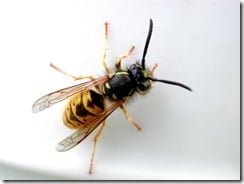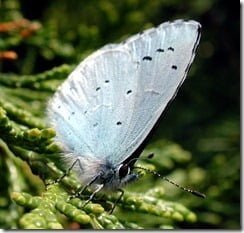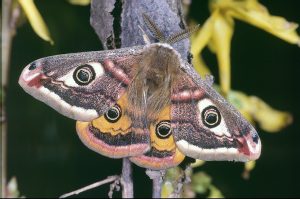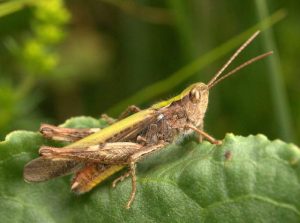 There are few animals in Ireland that provoke as much negative sentiment in people as the common wasp. It’s right up there with the brown rat as one of the nation’s least favourite animals.
There are few animals in Ireland that provoke as much negative sentiment in people as the common wasp. It’s right up there with the brown rat as one of the nation’s least favourite animals.
In truth though wasps are only really a nuisance between late August and the end of September. For the rest of the year, unless we inadvertently disturb an occupied nest, we’re generally unaware of these busy insects as they go about their daily business.
Like some species of bees and ants, common wasps are social insects, and live in colonies that can number upwards of 10,000 individuals during the late-summer peak. Unlike bees, wasps have no means of storing food over the winter, so wasp colonies die out in mid-autumn each year, with only the newly mated queens surviving the winter in hibernation.
With the warmer weather of late spring these young, fertile females stir from their slumber and immediately start looking for suitable sites to start a new colony. These range from disused animal burrows, to hollow trees, to garden sheds and even attics. Once a suitable spot has been found the queen will start to build her nest, chewing up small pieces of wood in her powerful jaws and mixing it with her saliva to form a papery pulp. Once she has constructed the first few chambers she will start to lay eggs which will hatch into larvae that eventually become the infertile female workers.
The queen will continue to actively build the nest, lay eggs and feed the resulting larvae until she has reared enough workers to take over the day to day running of the nest. Workers will then expand the nest, tend the eggs and actively forage for food to satisfy an ever increasing number of larvae. The queen will concentrate solely on egg-laying from then on, and a single queen may lay as many as 25,000 eggs over the summer.
While adult wasps feed on sweet liquids, larvae need protein-rich food and this is largely provided in the form of insect prey and carrion. Workers actively hunt insects and other invertebrates, subduing them with their powerful sting, breaking them apart and chewing them up with their strong jaws to form small food pellets for the growing larvae. In return the larvae exude a sweet fluid that is lapped up by the attending workers. This reciprocal feeding is thought to play an important role in the social nature of the colony.
The wasps’ sting is primarily used to subdue prey, but is also a very effective means of defence. Wasps will defend the nest aggressively if disturbed, and the sting is thought to release a pheromone, a chemical signal that triggers other wasps in the vicinity to attack, so it is best to leave a discovered nest well alone. The same pheromone is also released when a wasp is squashed; therefore swatting wasps is generally a bad idea if you want to avoid a sting.
Towards the end of the summer the queen lays the last of her eggs which will develop into male drones and fertile females… next year’s queens. Once mature these males and females leave the nest and mate. The males then die and the females seek out a warm place to wait out the winter.
Workers are coming to the end of their life-cycle now, and are particularly aggressive. With no larvae left to feed and no nest building to do they change their habits. Their attention turns from protein rich foods to the sweet substances that they need to replace the sugary secretions formerly provided by the larvae. This is when wasps are a real nuisance, and when we are most likely to come into painful conflict with them.
By early October the colder weather kills off the last of the workers and wasps disappear until the dormant queens re-emerge the following spring to start the cycle all over again.










31 comments
NIALL WEBB
Hibernating Queens.
I’ve just spent 10 days at our holiday Hut in Co. Wexford and so with the heating and lights on, day by day a total of 21 wasps emerged from Hibernation. I was able to chase two of them out into the cold and damp (although it’s unlikely they found another warm place and probably won’t survive), but I had to deal with the other 19 with a rolled up newspaper. I am surprised so many Queens would be hibernating in one small room.
Ray Kennan
Hi .Have a wasp nest in the eves under the extension out back.they are getting in and out by the grill beside the lightfittings… im happy to leave them “bee” but I was wondering when does the new queen leave as I want to block the grill they are using..
Thank you
Ray
Patricia breen
We have wasps eating through the main trunk of a miniature apple tree. Any suggestions??
Jack Shanahan
Had a wasp flew into my bathroom today, the 30th November, in Kerry. Outside temp 10 oC.. Seemed to be dying..
Angela
Last year I had wasps coming and going into the area just below my roof and above my bedroom window. I presumed they were building a nest in my attic. After a couple of months of activity they all seemed to die off. I didn’t take any action against them. I hoped that was the end of them but in late March they arrived back again to the same spot and have been very active since then. However in the last few days I’ve noticed that they are dying. I know they are pollinators and don’t want to harm them but can you tell me please am I being nieve and should I get the nest removed? Will they come back each year? And why are they dying so early in the summer? Angela
Margaret Anne Adams
We live 400 feet up,in the Rhins of Galloway and can see the Stena ferry going into Belfast Lough from our back windows. Our bees are still being pestered by wasps. I have trapped six litres of worker Vespula vulgaris wasps and we have only the two strongest colonies of bees leftleft. Is it unusual to have this problem over half way through October?
Calvin Jones
I’m sorry to hear about your bees, and yes is a bit unusual. Most colonies will have died off at this stage, with only a few hardy workers persisting and they too will soon perish. Only new queens hibernate overwinter to emerge and establish new colonies in spring. 6 litres of wasps sounds like an awful lot so there must have been a very large colony, or perhaps more than one, very close to where you have the hives. At this time of year any worker wasps that are around are only going to be interested in raiding honey, not killing the bees themselves (they hunt other insects through the summer as a protein-rich food source for growing larvae, but with no larvae to feed now they switch to foraging energy-rich food to feed themselves. That’s why we never find wasps a bother in the height of summer, but they can become a nuisance as we head into autumn). My concern would be that because they are so visible, and you are trapping so many, that leads to the understandable assumption that the wasps are the cause of the colony collapse you’re seeing, but they may not be. It may be worth checking your hives for less visible, more insidious issues (disease, parasitic infestation, etc.) just to rule them out.
Hopefully, there isn’t a more serious underlying problem, and the wasps will disappear over the coming weeks. I do hope your bees recover. Best of luck with it.
Keith Nevin
I have a wasp nest in the cavity of my house. (house is mass concrete, except this one spot after renovations)They have entered via a hole not fully sealed for electrics. The first time they got into one of the Rooms, I was fixing the skirting board, left the room, and when I returned 30 or 40 wasps were on the window. The next time, they managed to get through the expanding foam I used to block the gap. Is it true that the nest will no longer be used during the winter, that the existing queen dies – and the new queens fly off to mate, and then they find a new spot for the winter? I am considering waiting for the winter and just seal up their entry hole. Or should i consider some other measures?
Calvin Jones
Yes, Keith, the existing nest will either already be empty, or very soon will be, so your suggested course of action is the easiest and best solution. Simply make sure there are no access points over the coming months and the wasps will find somewhere else to nest next spring.
Jacinta
I filmed a white wasp in our lock woods in Waterford are they unusual ?
Clive Darling
I have a plant that self seeded in my garden with very tiny flowers, broad serrated leaf. I have never seen it anywhere else around Athlone BUT it is all over hedgerows in Kerry. Wasps seem to love it; perhaps 10 to 15 on it. They don’t touch lavender right beside it, where bumble bees are having a gorge. Any idea what the plant might be?
Calvin Jones
Any chance you could send a photo to info at irelandswildlife.com (remove the spaces and replace at with @) and I’ll take a look for you Clive.
Teresa O'Halloran
Had a wasp nest over my back door for a month tried to ignore it until the wasps attitude began to change this past week, and stung my little dog on the eyebrow, and found a way into the back kitchen through a gap in the slatted ceiling of my back kitchen. Worried my 94yr old mother would be stung next I rang Rentokil. As the nest wasn’t visible and the entry was under the slates in the roof they dusted the entryway and the wasps going in and out. The plan is that they will carry the dust into the nest where it will hopefully kill the queen. All this could take a week and we may need a second treatment. This first treatment cost €100 + €23 VAT. Fingers crossed.
adagaladriel
I have just found one of this grey round nest inside my shed. My garden is quite neglected at this moment, with very tall grass and weeds. Not sure what to do with the nest, should i leave it alone until mid autumn? Also, could there be any other nest hiding in the tall grass? Now i am frightened to cut and clean the grass.
Anthony S.
Is the size/length of the wasp’s all the same. just disposed of 3 look like your photo and
1 i measured was 3/4 inch (three quarters) long. Seems to be a lot of queens out this year.
Brian H
Collectioning apples from trees in small old orchard tday with a friend. Much undergrowth around apple trees. No sign of wasps but then my friend was stung after apparently standing on a nest on the ground beside one of the trees. Several of the little creatures then attacked us, string her five times on the lower body and me three times when I went to her assistance. V aggressive and determined. Had to undress indoors and shake the last one out of my clothes! Went back to the spot later and must have been a nest as they were defending a few feet of ground (with long grass over it) near one of the trees. Once one didn’t approach this patch they had no interest in my presence but boy are they aggressive if byou cross them!
Susanne Keane
I got stung today by wasps or bees – interfered with a nest inadvertently – they followed me to my house 15 meters away where I ran to after being stung into my ear – tried to shake off one or two around my head – ran in and out of house it kept stinging me into my neck then I received further sharp stings inside my shirt it took a while for me to realise it’s coming from inside my sweat shirt – pulled it off and killed the wasp/ bee and finally got rid of the one around my head -very painful ear which swell up first -other stings grew big but grew more itchy – I got itchy everywhere – hives developed , palpitations ,slight tongue swelling – went to doc received anti histamine and steroids in fluid form – 8 hrs later on painkillers and in recovery – trying to identify species – smaller than bees and inst of yellow stripe light brown stripe – the description re pheromones makes sense given that they followed and kept attacking me – extremely hard to shake them off.
Maighread
If I leave the nest there will they use it again next year?
Calvin Jones
No Maighread, the overwintering queen will typically find a new spot and start a new colony from scratch.
gina
Saw a wasp today that I’ve never seen before, segment body very bright yellow strip and carrying a bluebottle in its jaws. Have pictures. Anyone any idea?
patmim
Ah yes, agreed, it shouldn’t be first port of call. They do have some negative image though, Even the very small kids just seem to sense that they should be avoided even though there was not one sting involved in their stint with us,……
patmim
Rentokil came and injected something into mine. They did get very upset initially and tried to fly out of the cupboard in the eaves where they had made the nest to attack the Rentokil man. But the next day, less than 24 hours, I was able to climb into the cupboard and dismantle the nest and there were only a few stragglers still alive. They were annoyed but drowsy enough for me to be able to avoid them easily enough. Nest is now completely gone. €50 well spent as the nest was in our eaves but they were constantly invading the house through our kitchen windows and door and we had completely lost the use of the attic bedroom.
Calvin Jones
While there are ways to “deal” with a wasps nest, they’re usually not a problem as long as people give them a wide berth. Colonies only last a single season and the nest can be safely removed once the wasps have gone in the autumn.
There are some cases, of course, where intervention is necessary… but most of the time the best course of action is to leave them alone.
patmim
I left them as long as we could calvin. and only sought help once we had lost full use of one room in the house, the attic bedroom, and were beginning to lose control of a second, the kitchen diner, in a house of 2 adults and 5 children that’s a big concession to give. and why action had to be taken. sorry if you don’t approve……
Calvin Jones
Not disapproving in the slightest. Understand that this is one of those cases where intervention was necessary — just wanted to be clear that Rentokil shouldn’t be the first port of call if the wasps are doing no harm.
Thanks for taking the time to comment.
Conor Kelly
I think the photo actually shows a Vespula germanica (German, or European, wasp), rather than a Vespula vulgaris(Common wasp). But there isn’t much difference between them, I suppose.
I have a nest of V. vulgaris right outside my front door. B&Q’s spray-foam (D. Phenothrin 0.1% w/w and Tetramethrin 0.29% w/w) is having very little effect (two applications so far). I delivered the foam (at night-time) from the spray-can through a drinking-straw, as deep as I could into the nest, until it spilled out and completely covered the entrance. Repeated after 3 days. Still lots of activity the next day.
Help!
C.
Calvin Jones
Interesting Conor… will have to check that out and remedy it if it is the wrong species. Invertebrates… they can be a tricky lot!
Calvin Jones
Just looked at the photo again Conor and I think you may well be right… off out with the camera to try and get a shot of V. vulgaris to replace it.
Oops!
Thanks for pointing it out — and apologies for the delayed acknowledgement.
Bill Hunter
Did you know; The sting of the common Wasp – Vespula vulgaris – is actually the modified egg-laying organs of infertile female wasps. Only females can sting.
Bill Hunter
Did you know; Like social bees, a wasp releases pheromone when killed, this sends a signal to other wasps that danger is close and indicates that help is needed. A similar signal is released when they sting.
Bill Hunter
Did you know; Wasps are extremely sensitive to light. The best time to deal with a wasp nest is after daylight when they are inactive. But, as they are very beneficial insects, this should only be done where a nest constitutes a menace or danger.